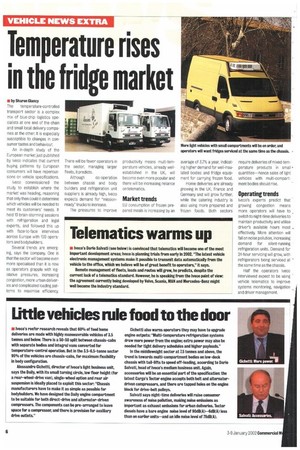Little vehicles rule food to the door
Page 6

If you've noticed an error in this article please click here to report it so we can fix it.
• Iveco's reefer research reveals that 60% of food home deliveries are made with highly manoeuvrable vehicles of 3.5 tonnes and below. There is a 50-50 split between chassis-cabs with separate bodies and integral vans converted for temperature-control operation. But in the 3.5-6.5-tonne sector 95% of the vehicles are chassis-cabs, for maximum flexibility in body configuration.
Alessandro Cichetti, director of Iveco's light business unit, says the Daily, with its small turning circle, low floor height (for a rear-wheel-drive van), single-wheel option and rear air suspension is ideally placed to exploit this sector: "Chassis manufacturers have to make it as simple as possible for bodybuilders. We have designed the Daily engine compartment to be suitable for both direct-drive and alternator-driven compressors. The components can be pre-arranged to leave space for a compressor, and there is provision for auxiliary drive outlets." Cichetti also warns operators they may have to upgrade engine outputs: "Multi-temperature refrigeration systems draw more power from the engine; extra power may also be needed for tight delivery schedules and higher payloads."
In the middleweight sector at 7.5 tonnes and above, the trend is towards multi-compartment bodies on low-deck chassis with tail-lifts to speed off-loading, according to Dario Salvati, head of Iveco's medium business unit. Again, accessories will be an essential part of the specification: the latest Cargo's Teeter engine accepts both belt and alternatordriven compressors, and there are tapped holes on the engine block for drive-belt pulleys.
Salvatl says night-time deliveries will raise consumer awareness of noise pollution, making noise emissions as important as exhaust emissions for urban deliveries. Tector diesels have a bare engine noise level of 90dB(4)-6dB(A) less than on earlier units—and an idle noise level of 78dB(A).




























































































































